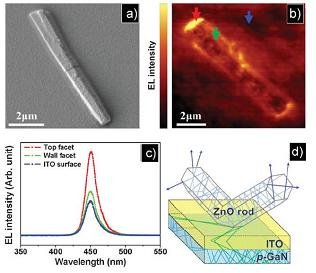New Fundamental Technology Increases Light Extraction Efficiency by 30%
Lee YouKyoung 2011-10-04 View. 8,752

New Fundamental Technology Increases Light Extraction Efficiency by 30%
A Korean research team has opened up the possibility to preoccupy the global LED lighting market.
The Ministry of Education, Science and Technology(Ahn Byung-man, Minister) said a Korean research team had developed a fundamental technology that increases the light extraction efficiency of InGaN green LED, a next-generation lighting source, by more than 30%.
Korean researchers increase green LED's efficiency to carve out global lighting market
Indium Gallium Nitride (InGaN)
Materials essential for forming active layers for white, blue, green, ultraviolet-ray LED
The study, which was led by Prof. Jung Gun-young from the department of new materials engineering at the Gwangju Institute of Science and Technology, and senior researcher Jeong Mun-seok of GIST's Advanced Photonics Research Institute. The study was conducted with support from the Basic Science Research Program and the Nano R&D Program, which are operated by the Ministry of Education, Science and Technology and the Korea Research Foundation.
The study was published as 'frontispiece' in the April 9 issue of Advanced Functional Materials.
LED, a next-generation lighting source, is a green energy technology that is highly sought after because of its high energy efficiency and eco-friendliness. Unlike conventional lighting such as light bulbs and florescent lights, LED technology presents high efficiency in the conversion of electric energy into light energy, and thus helps cut energy consumption by up to 90%.
If Korea replaces 30% of its lighting needs with LED lighting, the country can cut 16 billion kWh(volume equivalent to power generation volume of two 1 million kW-class nuclear power plants) from its electricity consumption, and effectively reduce 6.8 million tons of carbon dioxide emission.
"Aiming to preoccupy US$110 billion market by integrating with subsequent research"
The newly developed technology does not degrade the electrical characteristic of LED, when compared with the conventional LED, but rather increases light emitting efficiency by more than 30% through the "photo wave guide" effect in zinc oxide(ZnO) nanorods.
The photo wave guide effect refers to a technology that increases LED efficiency by creating a photo wave guide, a route through which light travels, in the LED device.
The researchers cultivated ZnO sub-microrods using a hydrothermal method on an ITO top contact layer of InGaN green LED(light emitting diode). Subsequently, the researchers investigated whether ZnO nanorods efficiently absorb and emit light generated from the LED by using a micro microscope they developed on their own.
Hydrothermal method
A method of synthesis conducted by melting a reactant in water and heating it up at temperatures below 100 degrees Celsius
As a result, the researchers discovered that when LED emits light, light transmitted via ZnO nanorods was efficiently extracted at the tip of the rods. Through this experiment, the research team demonstrated that ZnO nanorods served as a route for light transmission, and thus increased the light emitting efficiency of the LED structure.
Prof. Jung Gun-young said, "With the study, we have developed a fundamental technology that drastically increases light emitting efficiency in the aspect of materials costs and processing costs," adding, "If we fuse this technology with the results of our subsequent studies, we expect that Korea will be able to preoccupy the global LED lighting market, which is projected to reach US$ 110 billion in 2015."
?
Kim Chung-han
chkim at kofac.or.kr
[May 10, 2010]
- - - - - - -
Source - ScienceTimes

 Delete Article!
Delete Article!